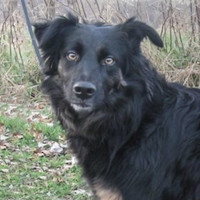Appearance of the Gordon Sheltie
|
| The Gordon Sheltie is well built, medium to large in size, with a long, glossy coat. The coat is straight, dense and double-coated. The Gordon Sheltie can come in a variety of colors, both bi and tricolors, the most important color being black, beige and white. It can have a slightly broad head and face, which may not be as broad as the Gordon Setter. Its muzzle is long and slightly pointed, and the ears are either fully folded back or partially folded back. Its eyes always seem cheerful and alert and can be dark brown, light brown, light blue or, in unique cases, a hybrid may have one eye of each color. The legs are of medium to long length, while the tail tends to be muscular and long with a slight curve but very feathered with long fur. |
Temperament of the Gordon Sheltie
|
| Strong-willed, loyal and loving all describe the temperament of your average Gordon Sheltie. These hybrids are active, family-oriented dogs that make excellent companions for homes with other pets and young children. They need to be socialized at a young age to set them up for success. Socialization and training are easy with these guys, as they are eager learners. When meeting strangers, these dogs bark a lot and, for the most part, will simply be cautious around new people. They are not known for being aggressive. The Gordon Sheltie can suffer from separation anxiety and boredom if left for too long, due to this trait, they are best suited to owners who will provide them with a mentally stimulating environment and won't be away from home for long hours throughout the day. |
Needs and activities of the Gordon Sheltie
|
| Easy to train and very energetic, the Gordon Sheltie is a hybrid that will thrive in the household that allows them to meet their daily energy needs. These dogs are intelligent and will love activities that let them feel they're working. Obedience classes and competitions, field trials, agility training and learning new tricks and commands are all considered fun for the Gordon Sheltie. A bored Gordon Sheltie can lead to destructive behavior, anxiety and excessive barking. These dogs are best suited to the outdoors, rural lifestyles or suburban homes with large yards and plenty of room to run. |
Maintenance of the Gordon Sheltie
|
| The Gordon Sheltie sheds seasonally, and its long coat can easily trap a lot of foreign matter. Owners are strongly advised to brush their hybrid once a week, if not daily, with a pin brush to remove dirt, leaves, twigs and loose fur. An active dog like this will pick up all kinds of debris when running, hunting and playing. Not only will the fur become matted, but the ears can accumulate dirt and moisture, so be sure to check and clean them often with a veterinarian-approved product. Don't neglect the teeth: to keep them white and rot-free, brush them at least three times a week. Trim fingernails as needed and check them often for tears or breaks. |









 English (United Kingdom)
English (United Kingdom)